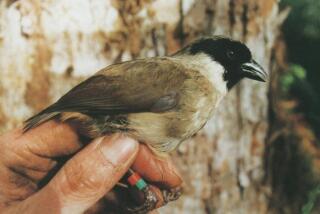Bad News--and Good
- Share via
The endangered-species score for this year in the United States is not encouraging: 37 species of plants and animals have been added, bringing to 450 the total of endangered or threatened species. And the last dusky seaside sparrow has died.
Thousands of those sparrows frolicked along the St. Johns River in Brevard County, Florida, until builders drained and paved their habitat. The sparrows were doomed to extinction on the day in 1980 when the last of five living birds was found and it was determined that all were males. The last survivor lived to a remarkable age of at least 10 years, and was weak and half-blind when it died the other day at Disney World’s Discovery Island refuge.
Not all of the news is bad. The Interior Department’s Fish and Wildlife Service reports the first litter produced in captivity by the black-footed ferret: Six kits were born last Saturday. All of the black-footed ferrets, like the condors in California, have been captured so that they can be used in controlled breeding programs--the last hope of ensuring survival. The red wolf will shortly be returned to the wild in North Carolina after a successful breeding program, according to Whitney Tilt of the National Audubon Society. Alligators in all habitats are no longer at risk. In the Everglades, where the population of Florida panthers has dwindled to fewer than 50, a federal refuge is being developed to provide more protection.
Each addition to the list of extinct species measures a problem of consequence--sometimes the inexorable work of nature, but more often than not the result of a failure by humankind to pay attention. Yet only the most shortsighted can fail to understand that human survival is closely tuned to the survival of all living things.
More to Read
Sign up for Essential California
The most important California stories and recommendations in your inbox every morning.
You may occasionally receive promotional content from the Los Angeles Times.













